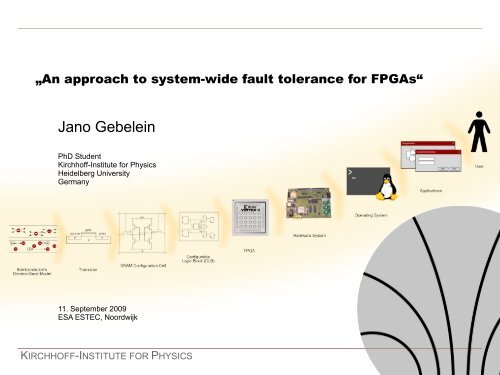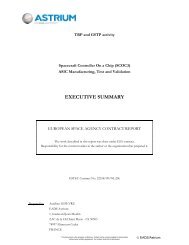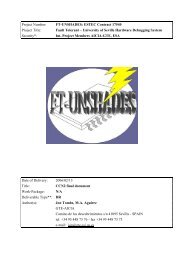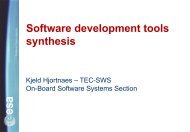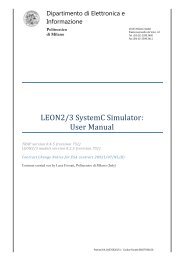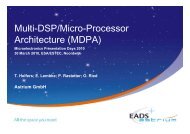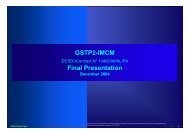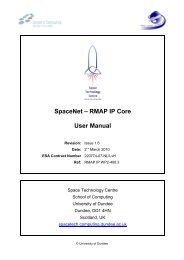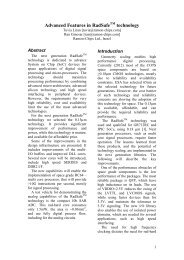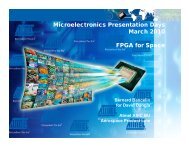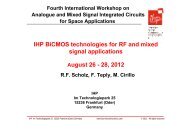Jano Gebelein - Microelectronics - ESA
Jano Gebelein - Microelectronics - ESA
Jano Gebelein - Microelectronics - ESA
You also want an ePaper? Increase the reach of your titles
YUMPU automatically turns print PDFs into web optimized ePapers that Google loves.
<strong>ESA</strong> Workshop on Fault-Injection and Fault-Tolerance tools for Reprogrammable FPGAs<br />
„An approach to system-wide fault tolerance for FPGAs“<br />
<strong>Jano</strong> <strong>Gebelein</strong><br />
PhD Student<br />
Kirchhoff-Institute for Physics<br />
Heidelberg University<br />
Germany<br />
11. September 2009<br />
<strong>ESA</strong> ESTEC, Noordwijk<br />
KIRCHHOFF-INSTITUTE FOR PHYSICS 1 JANO GEBELEIN
<strong>ESA</strong> Workshop on Fault-Injection and Fault-Tolerance tools for Reprogrammable FPGAs<br />
Kirchhoff-Institute for Physics (Reconf. Hardware)<br />
● years of experience in detector electronics<br />
● CERN (Geneva)<br />
ALICE Electron Trigger<br />
● GSI FAIR (Darmstadt)<br />
<br />
CBM Read-Out-Controller (Xilinx FPGAs)<br />
KIRCHHOFF-INSTITUTE FOR PHYSICS 2 JANO GEBELEIN
<strong>ESA</strong> Workshop on Fault-Injection and Fault-Tolerance tools for Reprogrammable FPGAs<br />
Ionizing Radiation Effects<br />
● ionizing particles increase # of electron-hole pairs by<br />
scattering electrons along their way<br />
● pairs try to recombine immediately, but<br />
● electric fields (e.g. powered transistors)<br />
hinder recombination<br />
– electron-hole pairs are separated<br />
– additional carriers in material (electrons & holes)<br />
● this leads to<br />
– Single Event Effects<br />
● destructive errors (SEL, SEBO, SEGR)<br />
● non-destructive errors (SEU, SET)<br />
– Cumulative Effects (Displacement, TID)<br />
KIRCHHOFF-INSTITUTE FOR PHYSICS 3 JANO GEBELEIN
<strong>ESA</strong> Workshop on Fault-Injection and Fault-Tolerance tools for Reprogrammable FPGAs<br />
CMOS fault-tolerance in brief<br />
● a lot of conventional CMOS techniques already exist<br />
● Heavy Ion Tolerant (HIT) cells [BV93]<br />
● Single Event Resistant Topology (SERT) [SM00]<br />
● Dual Interlocked Storage Cell (DICE) [CNV96]<br />
● ...<br />
● not applicable to FPGA hardware circuits<br />
● conflict with reprogrammability feature<br />
● circuit design becomes too expensive<br />
[BV93] Bessot, Velazco, “Design of SEU-hardened CMOS memory cells: the HIT cell”, RADECS 93<br />
[SM00] Shi, Maki, “New design techniques for SEU immune circuits”, NASA Symposium on VLSI Design, Nov, 2000<br />
[CNV96] Calin, Nicolaidis, Velazco, “Upset hardened memory design for submicron CMOS technology”, Nuclear Science Volume 43 1996<br />
KIRCHHOFF-INSTITUTE FOR PHYSICS 4 JANO GEBELEIN
<strong>ESA</strong> Workshop on Fault-Injection and Fault-Tolerance tools for Reprogrammable FPGAs<br />
FPGA fault-tolerance in brief<br />
● physically hardened chips<br />
● ceramics and advanced silicon<br />
● excessive shielding increases weight and size<br />
● slightly modified CMOS architecture<br />
● triple device redundancy<br />
● tripled costs, power supply, setup size<br />
● fault tolerant design<br />
● no limiting constraints<br />
hard-wired voter<br />
● unused chip area used for additional security features<br />
KIRCHHOFF-INSTITUTE FOR PHYSICS 5 JANO GEBELEIN
Xilinx FPGA<br />
<strong>ESA</strong> Workshop on Fault-Injection and Fault-Tolerance tools for Reprogrammable FPGAs<br />
● SRAM based runtime reprogrammable, but radiation<br />
susceptible<br />
● DCM: clear signaling,<br />
skew elimination<br />
● IOB: buffered inputs,<br />
grouped in banks for<br />
different standards<br />
● PPC: may offer<br />
embedded PowerPC<br />
● BRAM: SRAM-based<br />
memory with build-in-ECC<br />
on Virtex4, Virtex5<br />
● CLB: combinatorial logic, shift registers or RAM ff<br />
KIRCHHOFF-INSTITUTE FOR PHYSICS 6 JANO GEBELEIN
<strong>ESA</strong> Workshop on Fault-Injection and Fault-Tolerance tools for Reprogrammable FPGAs<br />
Upset risks for FPGA components ctd.<br />
● CLB + Routing Radiation Susceptibility<br />
KIRCHHOFF-INSTITUTE FOR PHYSICS 7 JANO GEBELEIN
<strong>ESA</strong> Workshop on Fault-Injection and Fault-Tolerance tools for Reprogrammable FPGAs<br />
Designing SEU-tolerant circuits<br />
● automated<br />
● TTM ++, area consumption --, power consumption --<br />
● everybody's tool, no additional knowledge about FT required<br />
● TMR tools under development:<br />
● manually<br />
– Partial TMR Tool (BLTmr) - Mike Wirthlin (BYU)<br />
– Xilinx TMR Tool (XTMR)<br />
– and others<br />
● TTM --, area consumption +, power consumption ++<br />
● extremely time-consuming<br />
● best optimization and fault tolerance results (designers know<br />
about their critical code patterns)<br />
KIRCHHOFF-INSTITUTE FOR PHYSICS 8 JANO GEBELEIN
<strong>ESA</strong> Workshop on Fault-Injection and Fault-Tolerance tools for Reprogrammable FPGAs<br />
Approach to system-wide fault-tolerance<br />
Layer<br />
Application<br />
Emulation<br />
Operating System<br />
System Architecture<br />
(HDL)<br />
FPGA Bit-Level<br />
Implementation<br />
regular end-user applications (maybe SWIFT applications)<br />
optional emulation of SWIFT features [RCVR05]<br />
handles error signals, Fastboot, MIPS Compiler, MIPS<br />
SWIFT Compiler<br />
configuration scrubbing via SelectMAP<br />
configuration management via Actel<br />
SWIFT - Software implemented fault-tolerance<br />
[RCVR05] Reis, Chang, Vachharajani, Rangan, August, Mukherjee, „Software-Controlled Fault Tolerance“, ACM Trans. on Architecture and Code Optimization 2005<br />
KIRCHHOFF-INSTITUTE FOR PHYSICS 9 JANO GEBELEIN
<strong>ESA</strong> Workshop on Fault-Injection and Fault-Tolerance tools for Reprogrammable FPGAs<br />
How to secure configuration matrix<br />
● eyecatcher: “Blind Scrubbing”<br />
● continuous refresh resets configuration memory (including<br />
errors) without performing a chip reset (exclusive Xilinx<br />
feature) „dynamic reconfiguration“<br />
● BRAM, FF, PPC untouched<br />
● refresh cycle less than a second<br />
● SysCore: Actel ProASIC 3 + Flash Memory<br />
– Actel connected to Virtex SelectMAP<br />
and 2x4MB Flash memory<br />
– Intended: file system on flash to select<br />
uploaded configuration file dynamically<br />
● watch out: do not use LUT as distributed RAM (SLICEM)<br />
or as shift registers, leave this for BRAM and Flip-Flops<br />
KIRCHHOFF-INSTITUTE FOR PHYSICS 10 JANO GEBELEIN
<strong>ESA</strong> Workshop on Fault-Injection and Fault-Tolerance tools for Reprogrammable FPGAs<br />
How to secure configuration matrix ctd.<br />
● validation results<br />
32-bit Shift Register Output<br />
Time [s]<br />
KIRCHHOFF-INSTITUTE FOR PHYSICS 11 JANO GEBELEIN
<strong>ESA</strong> Workshop on Fault-Injection and Fault-Tolerance tools for Reprogrammable FPGAs<br />
How to secure configuration matrix ctd.<br />
● counts 200:<br />
scrubbing continuously<br />
holds current at<br />
constant values<br />
routing shortage reduced<br />
scrubbing “on”<br />
[Røe] Ketil Røed, PhD thesis (to be published), private communication<br />
KIRCHHOFF-INSTITUTE FOR PHYSICS 12 JANO GEBELEIN<br />
[Røe]
<strong>ESA</strong> Workshop on Fault-Injection and Fault-Tolerance tools for Reprogrammable FPGAs<br />
How to secure System Architecture<br />
● mitigation techniques<br />
● double module redundancy for functional units<br />
can wait for the next reconfiguration cycle<br />
● triple module redundancy for dynamic data<br />
unrecoverable data has to be kept valid<br />
● Parity/CRC error detection/correction in data paths and<br />
buses<br />
prevent data pipelining failures<br />
● fault tolerant state machines (hamming-based state<br />
encoding with neighbored states have fixed/minimal<br />
Hamming distance)<br />
detect illegal state crossings<br />
● intended: maximum fault tolerance at minimum size<br />
KIRCHHOFF-INSTITUTE FOR PHYSICS 13 JANO GEBELEIN
<strong>ESA</strong> Workshop on Fault-Injection and Fault-Tolerance tools for Reprogrammable FPGAs<br />
How to intelligently secure CPU<br />
● pipeline stages are doubled<br />
● comparison of all stages<br />
before memory writeback<br />
● in case of difference:<br />
reset PC to last valid<br />
address and invalidate<br />
all following calculations<br />
● Program Counter is tripled (data has to be kept valid)<br />
● in case of error or watchdog: reset cpu (disables deadlocks)<br />
● keep in mind: Xilinx series 6 doesn't provide PowerPC<br />
[Eng09] Engel, “Development of a Fault Tolerant Softcore CPU for SRAM based FPGAs”, diploma thesis, 2009<br />
KIRCHHOFF-INSTITUTE FOR PHYSICS 14 JANO GEBELEIN<br />
[Eng09]
<strong>ESA</strong> Workshop on Fault-Injection and Fault-Tolerance tools for Reprogrammable FPGAs<br />
How to intelligently secure CPU ctd.<br />
● Error Handling:<br />
more at: IEEE proceedings FPL09 (P1.8) “An approach to system-wide fault tolerance for FPGAs”<br />
KIRCHHOFF-INSTITUTE FOR PHYSICS 15 JANO GEBELEIN
Beamtest<br />
● Beam parameters:<br />
<strong>ESA</strong> Workshop on Fault-Injection and Fault-Tolerance tools for Reprogrammable FPGAs<br />
● Ru96 ions at 1,69 GeV LET: 3,3·10 12 eV·cm 2 /kg (Bethe-Bloch)<br />
● flux at FPGA: 1,4·10 10 ≤ Φ ≤ 4,21·10 10 ions/cm 2<br />
● e - = 1,602·10 -19 C [J/V]<br />
● A = 1 cm 2 (approx. XC4VFX20)<br />
● TID rate = 100 · LET · Φ · e - / A = 740 krad to 2,23 Mrad<br />
● exceeds max. Virtex4 TID of 300 krad [FDLH08]<br />
<br />
scrubbing may have saved the chip<br />
[FDLH08] Fabula, DeJong, Lesea, Hsieh, “The Total Ionizing Dose Performance of Deep Submicron CMOS Processes”, MAPLD 2008<br />
KIRCHHOFF-INSTITUTE FOR PHYSICS 16 JANO GEBELEIN
<strong>ESA</strong> Workshop on Fault-Injection and Fault-Tolerance tools for Reprogrammable FPGAs<br />
CMOS architecture and TID<br />
● TID susceptibility for Xilinx Virtex (MIL-STD-883 testing<br />
method 1019 at full dose rate)<br />
● Virtex 220 nm 100 krad [FDLH08]<br />
● Virtex-II 150 nm 200 krad [FDLH08]<br />
● Virtex-II Pro 130 nm 250 krad [FDLH08]<br />
● Virtex-4 90 nm 300 krad [FDLH08]<br />
● Virtex-5 65 nm ~340 krad<br />
● Virtex-6 40 nm ~380 krad<br />
0 50 100 150 200 250<br />
90nm and 65nm test transistors “appear capable of<br />
operating through TID stress well in excess of 1 Mrad(Si)<br />
with proper design margins” [FDLH08]<br />
(= reduced Timing) [Sch96]<br />
[FDLH08] Fabula, DeJong, Lesea, Hsieh, “The Total Ionizing Dose Performance of Deep Submicron CMOS Processes”, MAPLD 2008<br />
[Sch96] Schwank, “Space and Military Radiation Effects in Silicon-on-Insulator Devices”, 1996<br />
[MIL-STD-883] http://www.dscc.dla.mil/Programs/MilSpec/listDocs.asp?BasicDoc=MIL-STD-883<br />
KIRCHHOFF-INSTITUTE FOR PHYSICS 17 JANO GEBELEIN<br />
TID (krad)<br />
400<br />
350<br />
300<br />
250<br />
200<br />
150<br />
100<br />
50<br />
0<br />
CMOS architecture (nm)
<strong>ESA</strong> Workshop on Fault-Injection and Fault-Tolerance tools for Reprogrammable FPGAs<br />
Single Event Effect calculations<br />
● #SEU = σ · Φ · ω / A<br />
● σ - cross section [cm 2 /bit]<br />
– depends on LET<br />
– given by Weibull Fit:<br />
varys by 2−4·10 −9 cm 2 /bit<br />
● Φ - particle flux [1/spill] = 1.7-5.0·10 5 ions/(cm 2 ·spill)<br />
● ω - design density [bit] = 7.242.624 (XC4VFX20)<br />
● A - FPGA chip area [cm 2 ] = 1 cm 2 (approx. XC4VFX20)<br />
● #SEU per particle = σ · ω / A = 0,014-0,029<br />
● #SEU per 15s spill = σ · Φ · ω / A = 2k to 15k<br />
KIRCHHOFF-INSTITUTE FOR PHYSICS 18 JANO GEBELEIN<br />
cross section<br />
[cm 2 /bit]<br />
[AA08]<br />
[AA08] Adell, Allen, “Assessing and Mitigating Radiation Effects in Xilinx FPGAs”, 2008
<strong>ESA</strong> Workshop on Fault-Injection and Fault-Tolerance tools for Reprogrammable FPGAs<br />
How to intelligently secure CPU ctd.<br />
● CPU Test results<br />
● GSI FOPI beamtime (3 weeks long-term test)<br />
– 96Ru (Z=44, 42+); 1.69 GeV<br />
– 5·10 6 ions / 15s spill<br />
– #SEU per 15s spill: 2k to 15k<br />
KIRCHHOFF-INSTITUTE FOR PHYSICS 19 JANO GEBELEIN
<strong>ESA</strong> Workshop on Fault-Injection and Fault-Tolerance tools for Reprogrammable FPGAs<br />
How to secure simple BRAM blocks?<br />
● BRAM<br />
● made of SRAM cells<br />
● therefore susceptible to radiation<br />
● increased susceptibility<br />
● SEU cross-section higher than for CLBs (Virtex4) [GKS+04]<br />
● maybe manufacturing issues: BRAM cells use smaller<br />
channels, thinner oxide, less metal than CLBs [GKS+04]<br />
● #MBUs for Virtex4 = 3·VirtexII = 69·Virtex [QGK+05]<br />
● mitigated chance of hit<br />
● general designs use more CLB configuration bits than<br />
BRAM bits theoretically balanced SEU cross-section<br />
[GKS+04] George Koga Swift Allen Carmichael Tseng, “SEUs in Xilinx Virtex-4 FPGA Devices”, 2004<br />
[QGK+05] Quinn Graham Krone Caffrey Rezgui Carmichael, “Radiation-Induced Multi-Bit Upsets in Xilinx SRAM-Based FPGAs”, 2005<br />
KIRCHHOFF-INSTITUTE FOR PHYSICS 20 JANO GEBELEIN
<strong>ESA</strong> Workshop on Fault-Injection and Fault-Tolerance tools for Reprogrammable FPGAs<br />
How to secure simple BRAM blocks? ctd.<br />
● current approach:<br />
● each 2 parallel ECC BRAM contain identical data<br />
– DMR implementation, but<br />
– ability to correct 2+ errors in a single word line<br />
● each 64bit line checked for errors via<br />
continuous loop<br />
– single error corrected and rewritten<br />
immediately<br />
– double error fetched from second<br />
ECC BRAM (max security)<br />
KIRCHHOFF-INSTITUTE FOR PHYSICS 21 JANO GEBELEIN
<strong>ESA</strong> Workshop on Fault-Injection and Fault-Tolerance tools for Reprogrammable FPGAs<br />
How to secure FPGA I/O Buffers (IOB)<br />
● can be secured by TMR [xapp197]<br />
● combinational logic tripled<br />
● I/O pins tripled and hard-wired outside FPGA<br />
(no external logic required)<br />
● I/O Buffers are not that critical [RWCG02]<br />
● just 1 of 324 IOB configuration bits and 2 two-bit<br />
combinations are able to flip an IOB behavior<br />
[RWCG02] Rollins, Wirthlin, Caffrey, Graham, „Reliability of Programmable Input/Output Pins in the Presence of Configuration Upsets“, 2002<br />
KIRCHHOFF-INSTITUTE FOR PHYSICS 22 JANO GEBELEIN
<strong>ESA</strong> Workshop on Fault-Injection and Fault-Tolerance tools for Reprogrammable FPGAs<br />
Upset risks for FPGA components<br />
● Configurable Logic Blocks (Routing, LUT, MUX)<br />
● Embedded Block RAM (no distributed SLICEM memory)<br />
● Flip-Flops in combinational logic<br />
● XtremeDSP Slices (DSP48) temporal Redundancy<br />
● Power PC (esp. internal Cache) FT Soft Core CPU<br />
● Digital Clock Managers (DCM) temporal sampling<br />
● I/O Buffers (IOB) 3x hard-wired<br />
everything is feasible<br />
Virtex6/Spartan6 without PPC instead more Slices<br />
feasible<br />
untouchable<br />
KIRCHHOFF-INSTITUTE FOR PHYSICS 23 JANO GEBELEIN
Lessons Learned<br />
<strong>ESA</strong> Workshop on Fault-Injection and Fault-Tolerance tools for Reprogrammable FPGAs<br />
● creating individual fault tolerant designs without TMR has<br />
to be done manually and is very time consuming<br />
● what we get:<br />
● instant fault tolerant system with default components<br />
● CPU standard MIPS architecture<br />
● Linux compatibility<br />
● maximum fault tolerance<br />
● PowerPC in Virtex is obsolete SoftCore CPU is required<br />
KIRCHHOFF-INSTITUTE FOR PHYSICS 24 JANO GEBELEIN
<strong>ESA</strong> Workshop on Fault-Injection and Fault-Tolerance tools for Reprogrammable FPGAs<br />
Questions? Please get in personal contact with me!<br />
KIRCHHOFF-INSTITUTE FOR PHYSICS 25 JANO GEBELEIN


